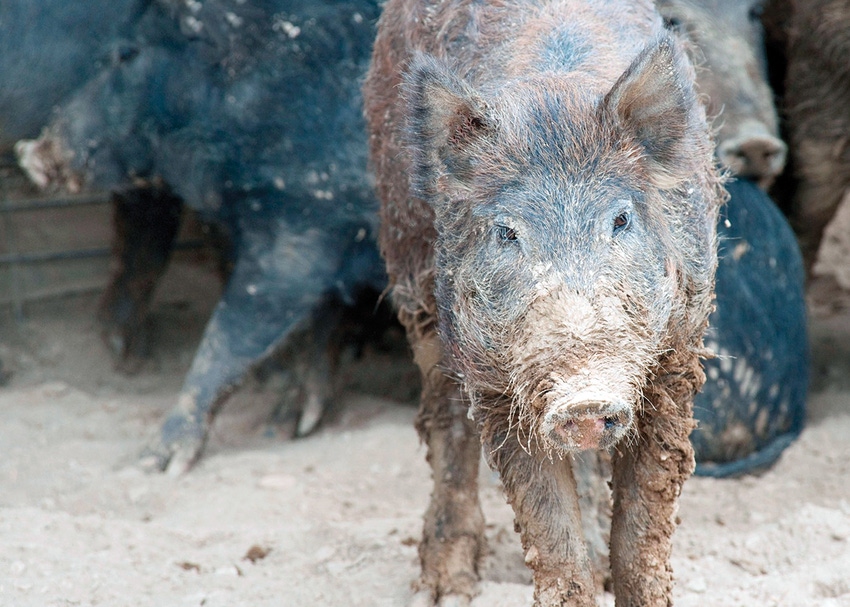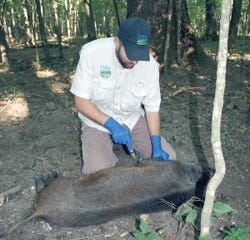
Epidemic. That's how ever-expanding feral hog populations are described by John Murry Greenlee, chairman of Delta Wildlife, who said that word was justified as farmers in more and more areas of the United States face unprecedented damage.
“Fortunately for us, effective control strategy work is being done here in Mississippi by the USDA Wildlife Services and the National Wildlife Research Center,” says Greenlee, who is also a landowner, hunter, and conservationist.
Fred Cunningham, project leader for the Wildlife Services, National Wildlife Research Center’s Mississippi Field Station, a biologist and doctor of veterinarian medicine, spoke to over 100 farmers at a recent Delta Wildlife meeting held in Stoneville, Miss., about projects he hopes will lead to a viable long-term solution.

USDA Wildlife Services disease biologist Jay Cumbee uses a syringe to extract a blood sample from a feral hog to be tested for pseudorabies and swine brucellosis. (Photo: USDA Wildlife Services)
USDA Wildlife Services disease biologist Jay Cumbee uses a syringe to extract a blood sample from a feral hog to be tested for pseudorabies and swine brucellosis. (Photo: USDA Wildlife Services)“This problem began over a century ago, and feral swine are now expanding their habitat by a half-million acres annually in Mississippi,” says Cunningham, who put the problem in perspective by explaining if you have 1,000 hogs in a section of your land, you would have to harvest 70 percent of them to limit next year’s population to 1,000.
The math is simple: There are around 6 million feral hogs in the U.S. today. Six million times 70 percent is 4.2 million hogs that would have to be harvested this year to keep their population number at 6 million next year — which Cunningham says is a daunting and potentially impossible task without better control methods.
“Hunting and trapping by landowners and hunters, combined with control efforts being conducted by Wildlife Services operations, are slowing population growth, but are not enough to actually reduce the population. Without new tools and methods, it’s probably going to get worse before it starts getting better - although some states with minimal populations may be able to reach manageable levels,” says Cunningham.
Research and toxicants
The sounder, or a herd of hogs, is the primary social unit usually comprised of one or more adult sows and typically, multiple generations of offspring. One or more mature boars will spend time with the sounder trying to mate, but will then move on searching for other sows.
Sows are ferocious protectors. Research confirms a high percentage of piglets survive, and little if any predation occurs in a sounder.
In one study, 20 piglets in a sounder were tracked. All survived past two weeks of age. If you are trapping hogs, Cunningham asks that you do it correctly. If trapped hogs escape, they will mostly likely become “trap shy” and never come near a trap again. He has photographic proof of this exact scenario.
“When we first started trapping pigs for research, it was easy, but because so many people use escapable traps, what used to take me a week to trap for research now takes me a month or more,” says Cunningham.
Sodium nitrite (NaNO2), a compound toxic to feral swine, is now being evaluated by a consortium consisting of Wildlife Services, National Wildlife Research Center (NWRC), Texas Parks and Wildlife, Texas A&M University-Kingsville and Australian and New Zealand researchers. Sodium nitrite reduces the ability of red blood cells to release oxygen to tissues, and swine are the most sensitive animals to it. The compound was mixed with corn as a bait source, but as the bait aged, it released gases that caused approaching pigs to sniff it and walk away.
“We are now using micro-encapsulation, which coats the sodium nitrite and increases the attraction of the bait by hiding the taste and smell,” says Cunningham.
Where are we now?
To make the bait more attractive to hogs, peanut paste is now being mixed with the encapsulated sodium nitrite. The mixture is then combined with black food coloring to reduce appeal to “non-target” species — which Cunningham says could be one of the biggest issues they will have to overcome.
“We have to make the bait taste better to the hogs so they’ll consume a lethal dose,” says Cunningham.
Once the sodium nitrite is consumed, the hog will progress through a series of degenerative physiological stages before succumbing.
Toxicants are regulated by the Environmental Protection Agency, which requires any new product undergo a series of evaluations before being granted approval. From creating an effective formulation (which they have done), to conducting a “confined pen study” that shows a mortality rate of 90 percent or greater, to considering secondary hazards (non-target species), the process toward commercialization is arduous and time consuming.
“Our biggest present worry is non-target species, especially scavengers, which when feeding on carcasses, concentrate on the stomach and intestines — the two areas where sodium nitrite levels are highest in hogs after ingestion and death,” says Cunningham.
Delivery system and questions
Bait stations are a vital part of effective hog control. They must be light, portable, durable, weather-resistant (because sodium nitrite does not hold up well in wet conditions), and easy to set up.
“Setting up a bait station is no easy task. You must pre-bait the area, install the bait station with the lid wired open, then lower the lid so it’s open only about 2 inches, and finally load the bait station. It can take up to 12 days until swine get comfortable with the process. Then the toxicant can be placed in with the bait. It’s not a one-step process,” says Cunningham.
How far should the bait stations be placed apart? How do we know if hogs have eaten bait? These are questions researchers are addressing, and they are addressing the latter using a bio-marker called Rhodamine B.
“We previously had to extract a tooth to determine if hogs had consumed our bait. Bio-markers are now available and cause their whiskers and hair to fluoresce. We think this will help us calculate how far apart bait stations need to be placed to gain effective coverage,” says Cunningham.
The scientists have applied for an EPA “Experimental Use Permit” which authorizes research and eventual field studies with the sodium nitrite toxicant. While a toxicant is not the overall answer, it is a critical piece of the overall hog control puzzle.
“We’re still looking at all options, including what could be the gold standard — genome mining, where we would knock out a gene that’s critical for the survival of a particular species. That’s way down the road, but we actually have scientists working on this right now,” says Cunningham.
“An economic figure of $1.5 billion has been used for the last several years as an estimate of annual hog damage, but researchers at NWRC are in the middle of a massive economic study right now to determine what that number is today,” says Cunningham.
About the Author(s)
You May Also Like




